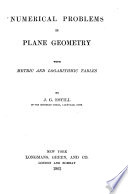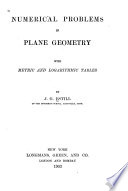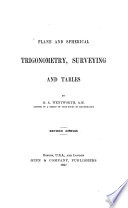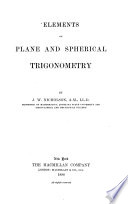 | George Albert Wentworth - Trigonometry - 1896 - 344 pages
...— = a — b = log A — log B. Jo 4. The logarithm of a power of a number is found by multiplying the logarithm of the number by the exponent of the power. For, A» - (10°)s = 10". Therefore, log A» =• an = n log A . 5. The logarithm of the root of a number... | |
 | Joe Garner Estill - 1896 - 186 pages
...logarithm of a quotient is equal to the logarithm of the dividend minus the logarithm of the divisor. III. The logarithm of any power of a number is equal to the logarithm of the number multiplied by the exponent of the power. IV. The logarithm of a root of a number... | |
 | Joe Garner Estill - 1896 - 214 pages
...logarithm of a quotient is equal to the logarithm of the dividend minus the logarithm of the divisor. III. The logarithm of any power of a number is equal to the logarithm of the number multiplied by the exponent of the power. IV. The logarithm, of a root of a... | |
 | George Albert Wentworth - Logarithms - 1897 - 384 pages
...— _ — n" — * °r' ~"6. The logarithm of a power of a positive number is found by multiplying the logarithm of the number by the exponent of the power. For, Nf = (a*y = a*>. . • . loga ( N') = np=p loga N. 1. The logarithm of the real positive value of a... | |
 | James William Nicholson - Trigonometry - 1898 - 204 pages
...10«'-''. .•. (Art. 1), log( - )= a' — 6', or by (A), log f § ] = log a — log b. \°/ 4. lll. The logarithm of any power of a number is equal to the logarithm of the number multiplied by the exponent of the power. For, Art. 2, (/)', a* = l0"'. ...... | |
 | George Albert Wentworth - 1898 - 112 pages
...log — = a — Ъ = log A — log B. 4. The logarithm of a power of a number is found by multiplying the logarithm of the number by the exponent of the power. For An = (10n)" = 10a". Therefore, log A" = an = n log A. 6. The logarithm of the root of a number is found... | |
 | George Albert Wentworth - Algebra - 1898 - 428 pages
...= a — ¿ = log A — log B. Ъ 414. The logarithm of a power of a number is found by nniltiplying the logarithm of the number by the exponent of the power. For An = (10n)" = 10"°. (§ 251) 415. The logarithm of the root of a number is found by dividing the logarithm... | |
 | Pitt Durfee - Plane trigonometry - 1900 - 122 pages
...logarithm of the divisor. Raising m = 10* to the £th power, m1ft = 10ift*, or log mk = kx = k log m. III. The logarithm of any power of a number is equal to the logarithm of the number multiplied by the exponent of the power. Since a root is a fractional power,... | |
 | James Harrington Boyd - Algebra - 1901 - 812 pages
...log,, 3 + log„ 5 - log„ 7 — loga 11. 558. The logarithm of any power, integral or fractional, of a number is equal to the product of the logarithm of the number and the index of the power. Thus loga (w") = n log „m. Proof. Let (1) m = a', (2) x = logam. [2555]... | |
 | James Harrington Boyd - Algebra - 1901 - 818 pages
...2 + logo 3 + loga 5 - loga 7 — log. 11. 558. The logarithm of any power, integral or fractional, of a number Is equal to the product of the logarithm of the number and the index of the power. Thus loga (m") = nlog(1TO. Proof. Let (1) m = a", (2) * = logam. [1555]... | |
| |